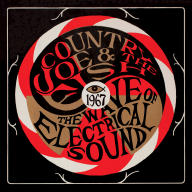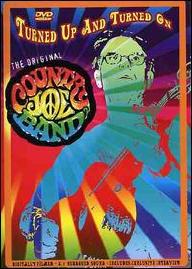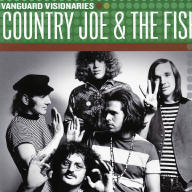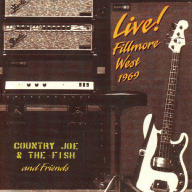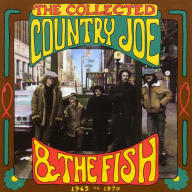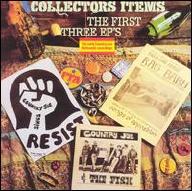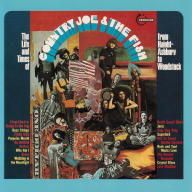Born on January 1, 1942 to a leftist-oriented family, McDonald was named in honor of Soviet leader Joseph Stalin. (In the context of World War II, Stalin was regarded by many on the left -- and even some apolitical observers in the United States and elsewhere -- as heroic, for being Hitler and Nazi Germany's greatest nemesis at a time when the governments of England, France, and the United States were waffling and dithering over what to do about German militarism).
McDonald was raised in the Los Angeles suburb of El Monte, where he grew up surrounded by all manner of political activity in support of labor unions and other leftist and progressive causes. He was also exposed to a massive amount of music, ranging from R&B to Dixieland jazz. His own early gigs were as a trombonist in jazz outfits and a guitarist in folk groups. He spent most of the early '60s serving in the Navy, in which he enlisted at age 18.
On returning to civilian life in 1964, McDonald resumed playing music and cut his first album in collaboration with Blair Hardman in 1964, titled The Goodbye Blues; he'd also started editing a radical magazine called Et Tu. Soon after, McDonald headed for Berkeley, California -- his official purpose was to attend college, but he quickly became a part of the city's burgeoning folk music scene. He mostly worked solo, playing songs by Pete Seeger, Lee Hays, and Woody Guthrie interspersed with some of his own compositions, and was devoted to politics. Vietnam wasn't yet a central issue, but civil rights, the economic embargo of Cuba, the working conditions of migrant farm laborers, America's role in decades of repressive politics of the Dominican Republic, and a Kennedy-era foreign policy initiative called Food for Peace were all on the agenda.
McDonald was a natural fit, and after some solo performances he formed two groups: one called the Berkeley String Quartet in conjunction with Bob Cooper on 12-string, Tom Lightjheiser on bass, and Carl Shrager playing washboard and doubling on guitar; and the other the Instant Action Jug Band. The latter, by its very nature, had a floating membership of as many as a dozen musicians, not all of whom would necessarily appear at every gig -- they were sort of like musical minutemen of the left, intended to show up on a moment's notice at whatever rally or street demonstration might be announced, on or off the campus. The jug band's ranks included Barry Melton, a prodigiously talented Brooklyn-born, Los Angeles-raised guitarist and singer who, in his mid-teens, had already amassed some serious performing credits at venues such as The Ash Grove before his family moved to Berkeley.
Out of their contact and the Instant Action Jug Band grew Country Joe the Fish, initially as a recording alias. Among McDonald's other activities in 1965, he was publishing a radical journal called Rag Baby. Accounts vary as to how the music side of Rag Baby came about -- some say that McDonald found himself with more music than articles on hand and decided to put out a "talking issue" of the magazine; other accounts say that he saw the need for the music to help support the journal and the cause, and thought he could sell copies of their records at demonstrations. Assuming the latter is true, it would make Country Joe the Fish among the very first -- if not the first -- music act to use self-produced records to promote themselves directly. He'd already cut an album independently and knew a little bit about getting records made and pressed, and the result was the Rag Baby EP, with four songs, two by Country Joe the Fish and two by a singer named Peter Krug, which saw the light of day in October of 1965. That lineup for Country Joe the Fish, in addition to McDonald on harmonica, acoustic guitar, and vocals, included Melton on vocals and electric guitar, plus Shrager on washboard and kazoo, Bill Steele on washtub bass, and Mike Beardslee on vocals.
The band's name, Country Joe the Fish, was a compromise proposed by ED Denson, an early member and the group's manager. He quoted Chinese communist leader Mao Zedong's metaphor about a revolutionary who resembled "the fish who swim in the sea of the people." There was also some thought given to the name "Country Mao & the Fish." Instead, they used "Country Joe" as a reference to McDonald, who was their singer and, as much as there was any organization to it at all, the organizer of the group, and also a reference to Joseph Stalin -- "Country Joe" was a nickname for the Soviet dictator. Ultimately, the name proved a stroke of genius, at once funny to the totally uninformed and provocative to those few who picked up the references, and also a goof on the typical, pop-oriented band names in an era filled with acts like Paul Revere the Raiders, Barry the Remains, and Mouse the Traps. It was such a good choice on so many levels that it was almost subversive, and what's more, it was subversive on levels that parents who worried over rock & roll never even dreamt of. And given McDonald's and Melton's politics, the name was even better than general analysis would lead one to believe -- in 1965, barely a decade after the peak of the McCarthy era and the Red Scare, and with California already the home of the John Birch Society (a right-wing organization whose founding credo included the notion that President [and former General of the Army] Dwight D. Eisenhower was a communist stooge), the meanings that went into the group's name were readily recognizable to any rightist ideologue.
The membership was in flux for a few months, and the music was mostly folk- and jug band-based as they built up an audience with performances at coffee houses such as the Jabberwock, and shows at the Avalon Ballroom and the original Fillmore Auditorium. They evolved into a rock group at about this time, playing electric instruments and, more to the point, real instruments. A second self-produced EP followed in June of 1966.By this time, McDonald and Melton were both playing electric guitars; Bruce Barthol, a 16-year-old friend of Melton's from high school, was in the lineup playing electric bass; New York-born, formally trained David Cohen joined on electric guitar and keyboards; Paul Armstrong, an alumnus of the Instant Action Jug Band, played guitar, bass, tambourine, and maracas; and jazzman John Francis Gunning played drums. The record was good enough to get the group gigs in San Francisco, at the Avalon Ballroom and the Fillmore Auditorium, and it was reviewed in Billboard magazine and even played on the radio as far away as New York City -- it seems to have circulated as far as London. Five months after its release, the group signed a contract with Vanguard Records, a New York-based record label had previously been known primarily for its releases of pre-Baroque and Baroque-era classical music and folk recordings.
Run by Maynard and Seymour Solomon, the company had stuck its neck out before by signing the reunited folk group the Weavers, who'd been blacklisted into premature retirement, but Country Joe the Fish presented new problems -- apart from being an electric band with a louder sound than anything they'd previously recorded, they had a repertoire of daring, challenging sounds that made them a potential West Coast answer to the Blues Project, perhaps even rivals to the Doors, the electric quartet just signed by Vanguard's indie label competitor Elektra. But they also had this political side, which Vanguard had faced before with artists such as the Weavers and Joan Baez (who was already becoming a lightning rod for the right with her anti-Vietnam and pro-civil rights activities). The difference was that Country Joe the Fish weren't remotely respectful in their political songs; they mixed rock & roll's youthful, rebellious attitude with a considerable level of awareness, and the mix was bracing but also a little frightening in the context of the times. Lyndon Johnson was still a popular president in most of the country outside the Deep South, and in early 1967, the only public figures who'd paid a price over the Vietnam War were a handful of Democrats who'd been defeated for opposing it.
Maynard Solomon heard the results of their recording sessions, held at Sierra Sound in Berkeley under the direction of Sam Charters, and he put "Super Bird" -- a savage swipe at Lyndon Johnson -- on the group's debut album, but insisted that "I Feel Like I'm Fixin' to Die Rag" be left off, despite its popularity at the group's live shows. Electric Music for the Mind and Body was released in February of 1967, and was embraced as a work of genius -- a bold, powerful mix of blues, jazz, classical, folk, and rock elements, all with a mesmerizing psychedelic glow. Listeners could luxuriate in Cohen's prodigious organ work, Melton's, Cohen's, and MacDonald's alternately lyrical and slashing guitars, McDonald's pleasing, light folk tenor, and the fluid rhythm section of Barthol and new drummer Gary Chicken Hirsh. The only thing it didn't have was a hit single -- "Not So Sweet Martha Lorraine" was issued as a 45 but peaked at number 98 nationally, though it got enough airplay on college stations so that, coupled with the play received by the non-single tracks "Section 43" and "Masked Marauder," and excellent word of mouth about the LP, Electric Music for the Mind and Body managed to make the Top 40 and stay there. It still holds up today, alongside Sgt. Pepper's Lonely Hearts Club Band, Van Dyke Parks' Song Cycle, the Jefferson Airplane's Surrealistic Pillow and After Bathing at Baxter's (which owed a lot to Electric Music), and Blood, Sweat Tears' Child Is Father to the Man as one of the enduring landmark albums of that year.
Vanguard, emboldened by the reaction to the first album (and relieved that "Super Bird" hadn't gotten it banned), had the group go back into the studio in the summer of 1967. This time out, the label let the band lead with "I Feel Like I'm Fixin' to Die Rag," the first track on the new album, and its title track. The sky didn't fall in and, indeed, the album sold well for over a year, charting in the Top 40 and becoming a staple of many collections -- one of the underappreciated bonus features, which showed how much the label was getting in on the spirit of the fun, was the inclusion in the early pressings of "The Fish Game," a highly satirical insert (which, in the '80s and '90s, would turn a $5 used copy of the LP into a $40 item). If the rest of the music wasn't quite as accomplished or bold as the content of the prior album, it was more accessible, offering McDonald a chance to show off his singing voice (which rivaled the Jefferson Airplane's Marty Balin), and together the two LPs represented the group's artistic and commercial peak. The band was soon touring nationally, and it was among the first acts to become known for its use of a light show at its concerts. An appearance at the Monterey Pop Festival in June of 1967 (and in the subsequent movie, doing "Section 43") utilizing the light show only enhanced the band's reputation musically.
Soon, "I Feel Like I'm Fixin' to Die Rag" took on a life of its own. The band had first recorded it before they were on Vanguard, as a folk number, and the version on the Vanguard album featured the most elaborate production yet. In the summer of 1968, the band appeared in New York City at the Shaefer Summer Music Festival, sponsored by the beer company, at the Wollman Skating Rink in Central Park. By that time, the mood of the country had darkened considerably -- the Democrats were split between pro- and anti-war factions, while the Republicans were capitalizing on negative reaction of white voters in the South in the first national election since the passage of landmark civil rights and voting rights legislation in the mid-'60s. And everybody seemed to either hate, or were just plain suspicious of, the motives of college students of the activist variety, who made up a big chunk of Country Joe the Fish's audience. Amid a lot of head-shaking and hand-wringing, many adults, even those with sons who could be drafted, seemed to wish that the majority of those "kids" would just act like willing cannon fodder and shut up. And the troop commitments stayed in the six-figure range.
In a moment that could be filed under "It Seemed Like a Good Idea at the Time" (and it was), the group was planning on playing "I Feel Like I'm Fixin' to Die Rag" at the Schaefer Festival when drummer Chicken Hirsh suggested that the opening, high school-style cheer ("Gimme an 'F,' gimme an 'I'") be changed to something a lot more...expressive. The cheer became an expletive, the crowd in those relatively innocent but darkening times devoured it, and the new cheer stuck -- the song as originally recorded got onto AM radio once again in its wake, and suddenly 12 and 13 year olds knew who Country Joe the Fish were.
To understand just what a deep, angry brand of black humor McDonald and company had tapped into -- if you were male and 14 or 15 or older, you knew that you'd be registering soon enough, and as the war had already lasted three years and there was no progress, it was hard to see why it wouldn't still be going on in three or four years. Lyndon Johnson, who'd seemed too popular for "respectable" people to attack over the war in late 1966, had announced he was leaving office, in near-disgrace politically; but many voters who were glad to see him go still felt the war was worth fighting if it could be won.
At some point, "I Feel Like I'm Fixin' to Die Rag" became a prism through which one could analyze the times and the mood of the country and its audience. Something similar had happened with another figure associated with the American left, Paul Robeson, and his performances of the Jerome Kern/Oscar Hammerstein II song "Ol' Man River" from Showboat. Although he wasn't the first man to play the role of Joe (the character who sang the song) in the musical, the song became inextricably associated with him, on-stage and later on record. As originally written and performed, the song had the opening line "N*ggers all work on the Mississippi," in keeping with the vernacular of the time; over the years, however, Robeson altered the words and other elements of the song, taking possession of it and turning it into a mirror of the particular time in which he performed it. It was "Darkies all work on the Mississippi" for the movie, and was later changed to "colored folks"; by the '50s, Robeson had altered the words enough to turn it into an anthem of liberation. McDonald and co. followed suit. By the time of Woodstock, where McDonald appeared solo, the producers had no qualms about recording the uncensored version of "The Fish Cheer," much less McDonald (there by himself, awaiting the arrival of the band) singing it in front of hundreds of thousands of people.
By that time, however, the best days of the band were over. In the fall of 1967, someone managed to convince McDonald that he was the real star of the group. Amid the ensuing turmoil, the Fish split up. It didn't last long, and they were eventually reassembled into a whole band, but the hiatus cost them dearly. Their third album, Together, was a recorded during this turmoil: MacDonald was almost invisible on most of the album, and Melton and Hirsh were the dominant performers. The group managed to tour Europe, and saw more demand for their performances in the U.S. as well; the continuing controversy over the Vietnam War helped keep their popularity high, and the growing underground enthusiasm for "I Feel Like I'm Fixin' to Die Rag" sustained them.
Alas, the lineup began coming apart at that point -- Bruce Barthol was dismissed in mid-1968, and Chicken Hirsh was gone by the end of the year. The next album, Here We Are Again, released in the spring of 1969, was the debut of the new lineup of the group which, apart from the Airplane's Jack Casady sitting in on bass, had David Getz, late of Big Brother the Holding Company, on drums. David Cohen's exit led to an all-star jam (including Jerry Garcia and Steve Miller) credited to the band at the Fillmore West, which was recorded and subsequently released as a Country Joe the Fish live album. The lineup stabilized around McDonald, Melton, Getz, and Peter S. Albin of Big Brother for six months in 1969. MacDonald reassembled the band for its appearance at Woodstock, and the final lineup of Melton, Mark Kapner on keyboards, Doug Metzner on bass, and Greg Dewey on drums, was the one that took advantage of the momentum coming off of that performance.
In the spring following the festival, McDonald embarked on a solo career, returning to his roots with an album of Woody Guthrie songs, and followed it up a year later with the electric blues album Hold on It's Coming. He remained committed to ending the Vietnam War, participating in demonstrations and appearing on-stage with The F.T.A. (F*ck the Army) Show, a satirical anti-military revue which yielded a movie of the same name and eventually earned a place on President Richard Nixon's notorious "enemies list." Melton continued in music into the '70s, but later became a lawyer.
Over the decades and well into the 21st century, McDonald cut numerous solo albums and performed extensively; he also revived Rag Baby. He periodically reunited with Melton -- whose presence is essential for the official use of the Country Joe the Fish name -- and Cohen, Barthol, and Hirsh, in the wake of the war in Iraq. He's become an almost mythic figure on the agit-prop scene since the early '80s, when he resumed his activist work -- wherever the American government seemed hell-bent on turning troops loose to kill people, he's there with his music, trying to answer the call to arms with something else. There are at least two extant best-of compilations devoted to the band, and in 1994, the Rag Baby EPs were reissued on compact disc.
In 2018, Craft Recordings issued the retrospective four-LP box set The Wave of Electrical Sound. The limited edition deluxe package included the band's first two influential albums from 1967 and I-Feel-Like-I’m-Fixin’-To-Die, the latter released in both mono and stereo versions on 180-gram vinyl. The mono version of Electric Music for the Mind and Body featured rare, alternate cover artwork. The Wave of Electrical Sound also contains a plentiful amount of ephemera from 1967, including replicas of The Fish Game, a Fish Fan Club book, and a Fish calendar designed by Tom Weller. Also included is a DVD of #How We Stopped the War, a 30-minute documentary, filming the band on their way to an anti-Vietnam War rally, directed by David Peoples (writer of Blade Runner, Twelve Monkeys, and Unforgiven), and a 24-page book comprised of rare photos, artwork, and a new liner essay from writer, producer, and musician Alec Palao. ~ Bruce Eder, Rovi


